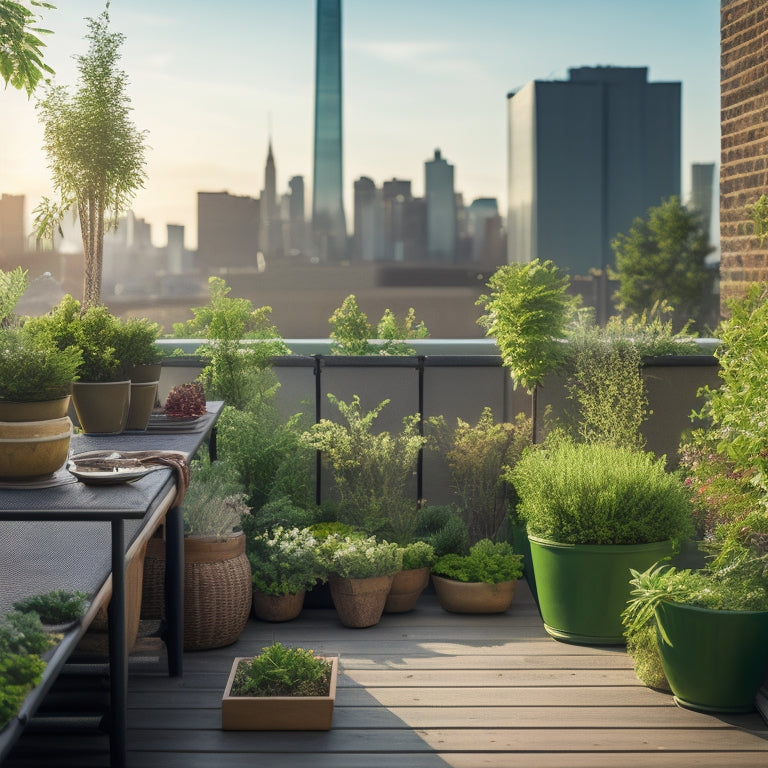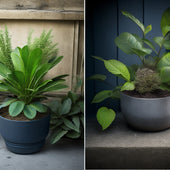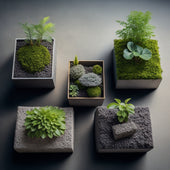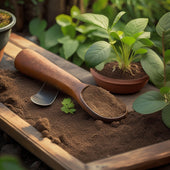
3 Compact Rooftop Garden Ideas for Fresh Flavors
Share
You can elevate your compact rooftop into a thriving garden, bursting with fresh flavors and aromas, by incorporating three innovative ideas that maximize space and productivity. Utilize hanging baskets to showcase tiny treasures like succulents, herbs, and small flowering plants, or opt for vertical gardens using walls and trellises to grow herbs, leafy greens, and strawberries. Alternatively, cultivate microgreens on your rooftop patio, harvesting them in as little as 7-10 days for a continuous supply of nutrient-dense greens. By exploring these ideas, you'll reveal the full potential of your rooftop space to savor the flavors of your labor.
Key Takeaways
• Utilize hanging baskets with succulents, miniature herbs, and small flowering plants for a compact and elegant rooftop garden.
• Incorporate vertical gardens using walls and trellises to maximize rooftop space and grow herbs, leafy greens, and strawberries.
• Cultivate microgreens in limited spaces, requiring minimal space, water, and maintenance, and harvest in 7-10 days for fresh flavors.
• Select plants based on sunlight exposure, such as succulents for full sun and flowering plants for partial shade, to ensure proper growth.
• Ensure well-draining potting mix and sturdy structures to support plants, soil, and irrigation systems for a thriving rooftop garden.
Tiny Treasures in Hanging Baskets
Hanging baskets overflowing with tiny treasures like succulents, miniature herbs, or small flowering plants can add a touch of elegance and whimsy to your rooftop garden.
When choosing plants for your hanging baskets, consider herb arrangements that include fragrant herbs like basil, rosemary, or thyme. These won't only provide a fresh flavor to your cooking but also attract pollinators and add a pop of color to your rooftop oasis.
To guarantee your hanging baskets thrive, make sure to use a well-draining potting mix and a sturdy basket that can support the weight of the plants and soil.
You should also consider the amount of sunlight your rooftop receives and choose plants accordingly. For example, if your rooftop gets full sun, opt for succulents or drought-tolerant herbs. If you have partial shade, choose flowering plants that thrive in low-light conditions.
With proper care and attention, your hanging baskets will soon be bursting with colorful blooms, adding a touch of beauty and freshness to your rooftop garden.
Vertical Gardens for Urban Spaces
As you maximize every inch of your rooftop garden, consider incorporating vertical gardens that make the most of your urban space. By utilizing walls, trellises, or living walls, you can create a thriving oasis in even the smallest of areas. This type of urban agriculture is perfect for city dwellers, as it provides a unique opportunity to grow your own fresh produce in a limited space.
When designing your vertical garden, guarantee you choose a sturdy structure that can support the weight of the plants, soil, and any additional features like irrigation systems. It's also essential to select plants that are suitable for vertical growth, such as herbs, leafy greens, or strawberries. Consider using a trellis or a wall-mounted planter to create a visually appealing display.
Remember to follow safety guidelines when working at heights, and consider enlisting the help of a professional if you're unsure about any aspect of the installation process. With a little creativity and planning, your vertical garden can become a vibrant and productive addition to your rooftop oasis, providing you with fresh flavors and a sense of accomplishment.
Microgreens on a Rooftop Patio
You can cultivate microgreens on your rooftop patio, taking advantage of the limited space to grow a variety of nutrient-dense greens that can be harvested in as little as 7-10 days.
Microgreens are young, immature greens that are rich in vitamins, minerals, and antioxidants. They're perfect for rooftop gardening, as they require minimal space, water, and maintenance. You can choose from a variety of microgreens, such as pea shoots, radish greens, and salad mix, each with its unique flavor and nutritional profile.
When growing microgreens on your rooftop patio, make certain to provide them with sufficient light, ideally 4-6 hours of direct sunlight per day. Use a well-draining potting mix and keep the soil consistently moist.
Microgreens are susceptible to contamination, so be certain you wash your hands before handling them and use clean equipment. Harvest your microgreens when they're 1-3 inches tall, using scissors to cut them just above the soil line.
With proper care, you can enjoy a continuous harvest of fresh, nutritious microgreens on your rooftop patio.
Frequently Asked Questions
How Often Should I Water My Rooftop Garden in Hot Weather?
"Wow, you're basically a rooftop garden whisperer, but let's get real, you're probably overwatering. In hot weather, water every 2-3 days, using techniques like drip irrigation, and choose drought-resistant plants to avoid, you know, plant murder."
Can I Grow a Rooftop Garden in a Shaded Area?
You can grow a rooftop garden in a shaded area by selecting shade-tolerant plants and adapting your garden design to maximize indirect sunlight, ensuring a safe and thriving oasis even in low-light conditions.
Do Rooftop Gardens Attract Pests and Unwanted Wildlife?
You wonder if rooftop gardens attract pests and unwanted wildlife. Research shows that they can, but implementing pest management strategies and wildlife deterrents, like bird-repellent balloons and fencing, can mitigate these issues effectively.
Are There Any Rooftop Garden Ideas for Windy Areas?
When creating a rooftop garden in a windy area, you'll want to choose wind-resistant plants and use sturdy planters with secure fastenings to prevent damage and guarantee safety, minimizing the risk of debris or plant loss.
Can I Use Recycled Materials for Building a Rooftop Garden?
You're building a rooftop oasis on a windy high-rise, and now you're wondering if you can get creative with recycled materials. Yes, you can! Repurpose old pallets, crates, or containers as planters, choosing sustainable materials that'll withstand harsh winds and weather.
Related Posts
-

What's the Ideal Timeline for a Concrete Planter Reno
You'll need to allocate around 6-12 weeks for a concrete planter renovation, broken down into seven distinct phases t...
-

What's the Ideal Timeline for a Concrete Planter Reno
You'll need to allocate around 6-12 weeks for a concrete planter renovation, broken down into seven distinct phases t...
-

What's the Ideal Timeline for a Concrete Planter Reno
You'll need to allocate around 6-12 weeks for a concrete planter renovation, broken down into seven distinct phases t...
-

What's the Ideal Timeline for a Concrete Planter Reno
You'll need to allocate around 6-12 weeks for a concrete planter renovation, broken down into seven distinct phases t...
-

What's the Ideal Timeline for a Concrete Planter Reno
You'll need to allocate around 6-12 weeks for a concrete planter renovation, broken down into seven distinct phases t...
-

What's the Ideal Timeline for a Concrete Planter Reno
You'll need to allocate around 6-12 weeks for a concrete planter renovation, broken down into seven distinct phases t...
-

What's the Ideal Timeline for a Concrete Planter Reno
You'll need to allocate around 6-12 weeks for a concrete planter renovation, broken down into seven distinct phases t...
-

What's the Ideal Timeline for a Concrete Planter Reno
You'll need to allocate around 6-12 weeks for a concrete planter renovation, broken down into seven distinct phases t...
-

What's the Ideal Timeline for a Concrete Planter Reno
You'll need to allocate around 6-12 weeks for a concrete planter renovation, broken down into seven distinct phases t...
-

What's the Ideal Timeline for a Concrete Planter Reno
You'll need to allocate around 6-12 weeks for a concrete planter renovation, broken down into seven distinct phases t...
-

What's the Ideal Timeline for a Concrete Planter Reno
You'll need to allocate around 6-12 weeks for a concrete planter renovation, broken down into seven distinct phases t...
-

What's the Ideal Timeline for a Concrete Planter Reno
You'll need to allocate around 6-12 weeks for a concrete planter renovation, broken down into seven distinct phases t...
-

What's the Ideal Timeline for a Concrete Planter Reno
You'll need to allocate around 6-12 weeks for a concrete planter renovation, broken down into seven distinct phases t...
-

What's the Ideal Timeline for a Concrete Planter Reno
You'll need to allocate around 6-12 weeks for a concrete planter renovation, broken down into seven distinct phases t...
-

What's the Ideal Timeline for a Concrete Planter Reno
You'll need to allocate around 6-12 weeks for a concrete planter renovation, broken down into seven distinct phases t...
-

What's the Ideal Timeline for a Concrete Planter Reno
You'll need to allocate around 6-12 weeks for a concrete planter renovation, broken down into seven distinct phases t...
-

What's the Ideal Timeline for a Concrete Planter Reno
You'll need to allocate around 6-12 weeks for a concrete planter renovation, broken down into seven distinct phases t...
-

What's the Ideal Timeline for a Concrete Planter Reno
You'll need to allocate around 6-12 weeks for a concrete planter renovation, broken down into seven distinct phases t...
-

What's the Ideal Timeline for a Concrete Planter Reno
You'll need to allocate around 6-12 weeks for a concrete planter renovation, broken down into seven distinct phases t...
-

What's the Ideal Timeline for a Concrete Planter Reno
You'll need to allocate around 6-12 weeks for a concrete planter renovation, broken down into seven distinct phases t...
-

What's the Ideal Timeline for a Concrete Planter Reno
You'll need to allocate around 6-12 weeks for a concrete planter renovation, broken down into seven distinct phases t...
-

Why Choose the Right Blocks for Your Planters
When creating a thriving planter, you need to choose the right blocks to support the entire ecosystem. Start by evalu...
-

Why Choose the Right Blocks for Your Planters
When creating a thriving planter, you need to choose the right blocks to support the entire ecosystem. Start by evalu...
-

Why Choose the Right Blocks for Your Planters
When creating a thriving planter, you need to choose the right blocks to support the entire ecosystem. Start by evalu...
-

Why Choose the Right Blocks for Your Planters
When creating a thriving planter, you need to choose the right blocks to support the entire ecosystem. Start by evalu...
-

Why Choose the Right Blocks for Your Planters
When creating a thriving planter, you need to choose the right blocks to support the entire ecosystem. Start by evalu...
-

Why Choose the Right Blocks for Your Planters
When creating a thriving planter, you need to choose the right blocks to support the entire ecosystem. Start by evalu...
-

Why Choose the Right Blocks for Your Planters
When creating a thriving planter, you need to choose the right blocks to support the entire ecosystem. Start by evalu...
-

Why Choose the Right Blocks for Your Planters
When creating a thriving planter, you need to choose the right blocks to support the entire ecosystem. Start by evalu...
-

Why Choose the Right Blocks for Your Planters
When creating a thriving planter, you need to choose the right blocks to support the entire ecosystem. Start by evalu...
-

Why Choose the Right Blocks for Your Planters
When creating a thriving planter, you need to choose the right blocks to support the entire ecosystem. Start by evalu...
-

Why Choose the Right Blocks for Your Planters
When creating a thriving planter, you need to choose the right blocks to support the entire ecosystem. Start by evalu...
-

Why Choose the Right Blocks for Your Planters
When creating a thriving planter, you need to choose the right blocks to support the entire ecosystem. Start by evalu...
-

Why Choose the Right Blocks for Your Planters
When creating a thriving planter, you need to choose the right blocks to support the entire ecosystem. Start by evalu...
-

Why Choose the Right Blocks for Your Planters
When creating a thriving planter, you need to choose the right blocks to support the entire ecosystem. Start by evalu...
-

Why Choose the Right Blocks for Your Planters
When creating a thriving planter, you need to choose the right blocks to support the entire ecosystem. Start by evalu...
-

Why Choose the Right Blocks for Your Planters
When creating a thriving planter, you need to choose the right blocks to support the entire ecosystem. Start by evalu...
-

Why Choose the Right Blocks for Your Planters
When creating a thriving planter, you need to choose the right blocks to support the entire ecosystem. Start by evalu...
-

Why Choose the Right Blocks for Your Planters
When creating a thriving planter, you need to choose the right blocks to support the entire ecosystem. Start by evalu...
-

Why Choose the Right Blocks for Your Planters
When creating a thriving planter, you need to choose the right blocks to support the entire ecosystem. Start by evalu...
-

Why Choose the Right Blocks for Your Planters
When creating a thriving planter, you need to choose the right blocks to support the entire ecosystem. Start by evalu...
-

Why Choose the Right Blocks for Your Planters
When creating a thriving planter, you need to choose the right blocks to support the entire ecosystem. Start by evalu...
-

Why Choose the Right Blocks for Your Planters
When creating a thriving planter, you need to choose the right blocks to support the entire ecosystem. Start by evalu...
-

Why Choose the Right Blocks for Your Planters
When creating a thriving planter, you need to choose the right blocks to support the entire ecosystem. Start by evalu...
-

What Makes a Good Used Trowel for Planters
When searching for a good used trowel for planters, you'll want to prioritize corrosion-resistant materials like stai...
-

What Makes a Good Used Trowel for Planters
When searching for a good used trowel for planters, you'll want to prioritize corrosion-resistant materials like stai...
-

What Makes a Good Used Trowel for Planters
When searching for a good used trowel for planters, you'll want to prioritize corrosion-resistant materials like stai...
-

What Makes a Good Used Trowel for Planters
When searching for a good used trowel for planters, you'll want to prioritize corrosion-resistant materials like stai...
-

What Makes a Good Used Trowel for Planters
When searching for a good used trowel for planters, you'll want to prioritize corrosion-resistant materials like stai...
-

What Makes a Good Used Trowel for Planters
When searching for a good used trowel for planters, you'll want to prioritize corrosion-resistant materials like stai...
-

What Makes a Good Used Trowel for Planters
When searching for a good used trowel for planters, you'll want to prioritize corrosion-resistant materials like stai...
-

What Makes a Good Used Trowel for Planters
When searching for a good used trowel for planters, you'll want to prioritize corrosion-resistant materials like stai...
-

What Makes a Good Used Trowel for Planters
When searching for a good used trowel for planters, you'll want to prioritize corrosion-resistant materials like stai...
-

What Makes a Good Used Trowel for Planters
When searching for a good used trowel for planters, you'll want to prioritize corrosion-resistant materials like stai...
-

What Makes a Good Used Trowel for Planters
When searching for a good used trowel for planters, you'll want to prioritize corrosion-resistant materials like stai...
-

What Makes a Good Used Trowel for Planters
When searching for a good used trowel for planters, you'll want to prioritize corrosion-resistant materials like stai...
-

What Makes a Good Used Trowel for Planters
When searching for a good used trowel for planters, you'll want to prioritize corrosion-resistant materials like stai...
-

What Makes a Good Used Trowel for Planters
When searching for a good used trowel for planters, you'll want to prioritize corrosion-resistant materials like stai...
-

What Makes a Good Used Trowel for Planters
When searching for a good used trowel for planters, you'll want to prioritize corrosion-resistant materials like stai...
-

What Makes a Good Used Trowel for Planters
When searching for a good used trowel for planters, you'll want to prioritize corrosion-resistant materials like stai...
-

What Makes a Good Used Trowel for Planters
When searching for a good used trowel for planters, you'll want to prioritize corrosion-resistant materials like stai...
-

What Makes a Good Used Trowel for Planters
When searching for a good used trowel for planters, you'll want to prioritize corrosion-resistant materials like stai...
-

What Makes a Good Used Trowel for Planters
When searching for a good used trowel for planters, you'll want to prioritize corrosion-resistant materials like stai...
-

What Makes a Good Used Trowel for Planters
When searching for a good used trowel for planters, you'll want to prioritize corrosion-resistant materials like stai...
-

What Makes a Good Used Trowel for Planters
When searching for a good used trowel for planters, you'll want to prioritize corrosion-resistant materials like stai...
-

What Makes a Good Used Trowel for Planters
When searching for a good used trowel for planters, you'll want to prioritize corrosion-resistant materials like stai...
-

What Makes a Good Used Trowel for Planters
When searching for a good used trowel for planters, you'll want to prioritize corrosion-resistant materials like stai...
-

What Makes a Good Used Trowel for Planters
When searching for a good used trowel for planters, you'll want to prioritize corrosion-resistant materials like stai...


